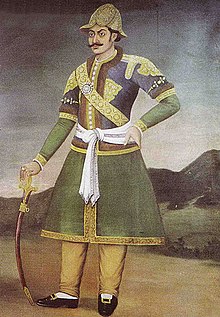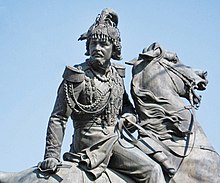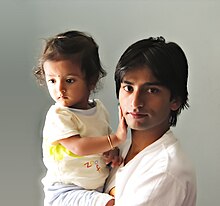|
Chhetri
Chhetri (Kshetri, Kshettri, Kshetry or Chhettri), (Nepali: क्षेत्री pronounced [tsʰetri]; IAST: Kṣetrī) historically called Kshettriya or Kshetriya or Khas are Nepali speaking indo-aryans historically associated with the warrior class and administration, some of whom trace their origin to migration from medieval India.[4][5] Chhetri was a caste of administrators, governors, warriors and military elites in the medieval Khas Kingdom and Gorkha Kingdom (later unified Kingdom of Nepal).[6] The nobility of the Gorkha Kingdom mainly originated from Chhetri families. They also had a strong presence in civil administration affairs.[7] The bulk of prime ministers of Nepal before the democratization of Nepal belonged to this caste as a result of the old Gorkhali aristocracy. Gorkha-based aristocratic Chhetri families included the Pande dynasty, the Basnyat dynasty, the Kunwar family (and their offspring branch, the autocratic Rana dynasty) and the Thapa dynasty. From 1806 to 1951, Chhetri prime ministers wielded absolute rule in the country and the monarchy was reduced to a powerless figurehead.[8] Khas Chhetris were traditionally considered a division of the Khas people with Khas Brahmin (commonly called Khas Bahun).[9] They make up 16.45% of Nepal's population according to the 2021 Nepal census, making them the most populous caste or ethnic community in Nepal.[10] Chhetris speak an Indo-Aryan Nepali language (Khas-Kura) as mother tongue.[2][4] Etymology and backgroundChhetri is considered a direct derivative of the Sanskrit word Kshatriya from the root kṣatra meaning "rule or authority" which was associated with the ruling and warrior class of Hindu society.[11][12][13] According to the 1854 Legal Code (Muluki Ain) of Nepal, Chhetris were a social group among the sacred thread bearers (Tagadhari) and twice-born people of the Hindu tradition.[14][15] Almost all Chhetris are Hindu.[16] The term 'Chhetri' was adopted by a lot of the high-ranking Khas after the unification of Nepal,[17] and it was formalized by an order of Bir Narsingh Kunwar(Jang Bahadur Rana), who considered their original name (Khasa) to be derogatory. The family occupation of Chhetris The caste system of Nepal was decided according to the occupation they did from the ancestors of their family, known as Dharma (Devanagari:धर्म). The family occupation of Brahmin was Guru or the spiritual leader in Hinduism whereas that of Chhetri was military and political leaders. Hence, the majority of military and political positions have been historically occupied by Chhetris until now. [note 1] History  They are thought to be connected to the Khasas mentioned in the ancient Indian literature and the medieval Khasa kingdom.[18] In the early modern history of Nepal, Chhetris played a key role in the Unification of Nepal, providing the core of the Gorkhali army of the mid-18th century.[19] Bir Bhadra Thapa was a Thapa of Chhetri group[20] and leading Bharadar during Unification of Nepal.[21] His grandson Bhimsen Thapa became Mukhtiyar (Prime Minister) of Nepal.[21] Swarup Singh Karki, a leading politician and military officer, belonged to Chhetri family.[22] Abhiman Singh Basnyat of Basnyat dynasty, Damodar Pande of Pande dynasty were both members of Chhetri caste.[23] and Jung Bahadur Rana, founder of Rana dynasty also belonged to the Chhetri community.[24] For 104 years since the middle of the 19th century until 1951, hereditary Rana prime ministers wielded absolute rule in the country relegating the monarchy to a mere figurehead.[8] During the monarchy, Chhetris continued to dominate the ranks of the Nepalese government, Nepalese Army, Nepalese Police and administration.[19] Chhetri noble families The most prominent feature of Nepalese Chhetri society has been the Rana Prime Ministers (1846–1953), the Pande family, the Thapa family, and the Basnyat family,[7] all of whom held prominent positions in the Gorkha kingdom, and increased the Chhetri presence in the armed forces, police, and Government of Nepal. In traditional and administrative professions, Chhetris were given favorable treatment by the royal government.[25][26] Chhetri and premiershipThe nobility of Gorkha were mainly from Chhetri families and they had strong presence in civil administration affairs.[7] All of the Prime Minister of Nepal between 1768 and 1950 were Chhetris with the exception of Ranga Nath Poudyal, being a Bahun, and Fateh Jung Shah, being a Thakuri.[27] These number varied after the democratization of Nepal. Between 1951 and 1997, out of the 16 Prime Ministers of Nepal, 5 of them were Chhetris.[28] 
Military achievements  Chhetri had dominated high military positions and monopolized the military force at the times of Chhetri autocratic administrators like PM Bhimsen Thapa and PM Jung Bahadur Rana. There were 12 Basnyats, 16 Pandes, 6 Thapas and 3 Kunwar officers totalling to 51 Chhetri officers in the year 1841 A.D.[24] The most prominent officers at Shah administration were the Kazis which had control over civil and military functions like a Minister and Military officer combined. Rana Jang Pande, the leader of Pande faction, was the Prime Minister of Nepal in 1841 A.D.[29] which might have caused an increase in the number of Pande officers at 1841. After the rise Rana dynasty(Kunwars), the number changed to 10 Basnyats, 1 Pandes, 3 Thapas and 26 Kunwar officers totaling to 61 Chhetri officers in the year 1854 A.D.[24]Chhetris dominated the position of the senior officers of the Nepali Army comprising 74.4% of total senior officers in 1967. Similarly, Chhetris composed 38.1%, 54.3% and 55.3% of the senior officers in the year 2003, 2004 and 2007 respectively.[30]    Anglo-Nepalese War and Nepal-Tibet War  Chhetri commanders and generals of the military campaigns of the kingdom of Nepal have shaped the political course of the country overwhelmingly. Anglo-Nepalese War fought between the British forces and the army of Kingdom of Nepal was commanded by Bhimsen Thapa, Amar Singh Thapa, Ujir Singh Thapa, Ranabir Singh Thapa, Dalbhanjan Pande, Bakhtawar Singh Thapa and Ranajor Singh Thapa from 1814 to 1816 and led to a peace treaty with the British and maintained the independence of Nepal during the British Company rule and British Raj in South Asia from 18th to 20th century.[32] Nepal-Tibet War (1855-1856), commanded by Bam Bahadur Kunwar, Sanak Singh Khatri, Prithvi Dhoj Kunwar, Dhir Sumsher and Krishna Dhoj Kunwar under the authority of Jung Bahadur Rana, resulted in the victory of Nepalese troops whereby the Tibetans had to pay an annual subsidy of ten thousand rupees to Nepal and were made to allow the establishment of a Nepalese trading station and agency in Lhasa.[33] Religion Almost all the Chhetris are Hindus, and form the largest Hindu adhering sub-group of Nepal representing 99.3% of their population, and those who are Hindus may also follow Buddhism; the Buddha being worshipped as the ninth avatar of god Vishnu.[34] Chhetris have historically practiced Hindu polytheism which included the worship of Khas Masto sect of Shaivism, clan deity (Kuldevta), their personal favorite deity (Ishta-devata), fierce forms of Shiva (such as Virabhadra and Rudra) and goddesses such as Adi Shakti, Kali and Bhadrakali. Owing to the extensively large number of Chhetri generals and commander-in-chiefs in the Nepalese Army (formerly known as Gorkha Army), goddess Bhadrakali, an auspicious form of Kali, was the patron deity of the army and her worship was necessary before and during wars.[35] The war cry, "Jay Mahakali, Ayo Gurkhali " meaning "Hail Great Goddess Kali, here come the Gurkhas!", invoked the sense of protection from Goddess Kali during battles and today is the war slogan of the Nepalese Army as well as Gurkha regiment of the Indian Army and the British Army.[36] Families & surnames Surnames of Chhetris include, among others:[37]
Demographics  The Central Bureau of Statistics of Nepal classifies Chhetris as a subgroup within the broader social group of Khas Arya (together with Thakuri and Sanyasi/Dasnami).[38] The 2021 census recorded Chhetri population of Nepal as the largest community with a population of 4,796,995 (16.4% of Nepal). Previously, the 2011 Nepal census showed Chhetris as the largest Hindu adherents in the nation with 4,365,113 people which was 99.3% of total Chhetri population.[39] In Nepal's hill districts the Chhetri population rises to 41% compared to 31% Brahmin and 27% other castes. This greatly exceeds the Kshatriya portion in most regions with predominantly Hindu populations.[40][41] As per 2021 census, Chhetris are largest caste group in 27 districts of Nepal, increase from 21 districts of 2001 Nepal census and 24 districts of 2011 Nepal census. [42] These twenty seven districts are - Sankhuwasabha district, Okhaldhunga district, Dhankuta district, Morang district, Udayapur district, Dolakha district, Ramechhap district, Gulmi district, Dang district, Salyan district, Western Rukum district, Surkhet district, Dailekh district, Jajarkot district, Dolpa district, Jumla district, Mugu district, Humla district, Bajura district, Bajhang district, Achham district, Doti district, Dadeldhura district, Baitadi district, Darchula district, Kalikot district, and Kanchanpur district. The district with the largest Chhetri population is Kathmandu district with 424,172 (i.e. 20.7% of the total district population).[39] [42] Chhetris form the second largest demographic group after Newars in the Kathmandu Valley, together with Lalitpur (Patan) and Bhaktapur, with a population of 621,346. Other districts with more than 150,000 Chhetri population are Kailali, Kanchanpur, Dang, Jhapa and Morang. [42] Province wise, Chhetris are majority demography in Koshi Province, Karnali Province and Sudurpashchim Province. [42] The frequency of Chhetris by province is shown in the table:[43]
As per the Public Service Commission of Nepal, Brahmins (33.3%) and Chhetris (20.01%) were the two largest caste groups to obtain governmental jobs in the fiscal year 2017–18, even though 45% governmental seats are reserved for women, Madhesis, lower caste and tribes, and other marginalized groups.[44]   The frequency of Chhetris was higher than national average (16.4%) in the following districts:[43]
Present day Chhetri together with Bahun and Thakuri fall under Khas Arya, who are denied quota and reservations in civil services and other sectors due to their history of socio-political dominance in Nepal.[45] There are no quotas for the Khas community who fall under Bahun-Chhetri-thakuri hierarchy.[46] As per the explanation of legal provisions of Constitution of Nepal, Khas Arya comprises the Brahmin, Kshetri, Thakur and Sanyasi (Dashnami) communities.[47] But they are allowed reservation in federal parliament and provincial legislature.[48] The European Union has been accused of direct interference, creating ethnic strife and negative discrimination towards Khas Arya due to their recommendation to remove the reservation for Khas Aryas.[49][48] Notable people
See alsoReferencesFootnotes
Citations
Sources
Further reading
|
|||||||||||||||||||||||||||||||||||||||||||||||||||||||||||||||||||||||||||||||||||||||||||||||||||||||||||||||||||||||||||||||||||||||||||||||||||||||||||||||||||||||||
